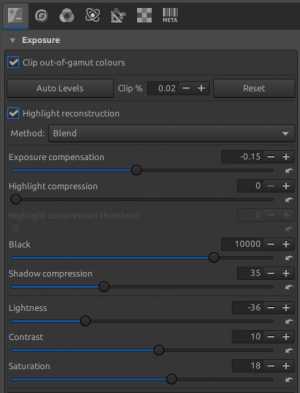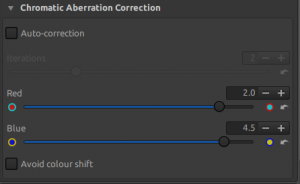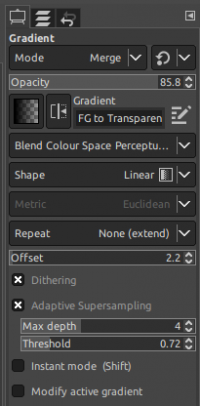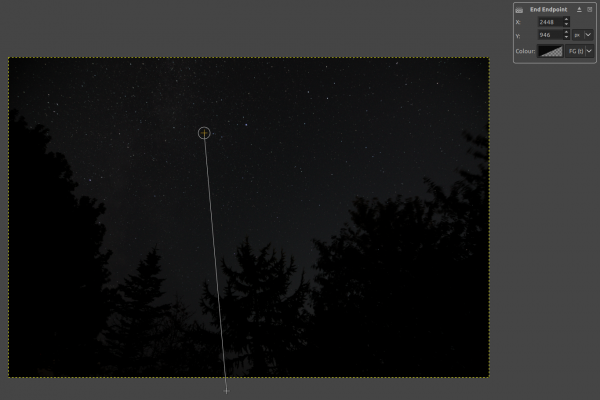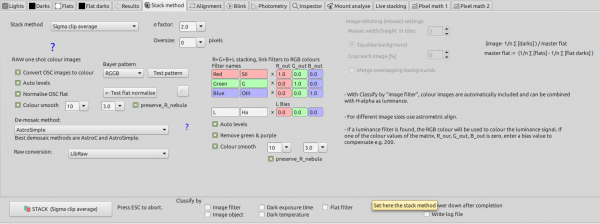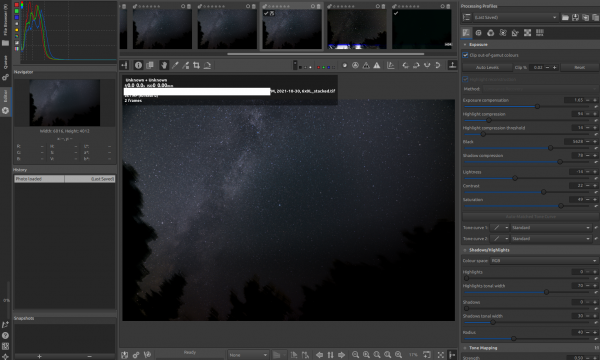Table of Contents
Night Sky Images - 25/10/2021
Clear for most of the night. After successfully using the tracker a week or two earlier I managed to get hold of a remote shutter release cable to allow the tracker to automatically trigger the camera - my previous testing was several manual shutter release image (I don't have an external intervalometer at this point).
I took two different images of the night sky - roughly pointing in the same direct, just at a different elevation; one at tree-top level, the other almost vertically up.
Gear:
- Canon EOS 200D
- Tokina AT-X Pro SD 11-16mm f/2.8 (IF) DX
- Tripod
- Star Adventurer 2i tracking mount (with shutter release cable)
Weather:
- Clear (zero cloud for most of the night)
Location:
- Garden
Software
- Rawtherapee - RAW file importing, optical correction & image processing
- ASTAP - Image stacking / general astrophotography toolset
- GIMP - RAW/TIF to JPEG, cropping
Images
First image was taken from a sequence of 5x 30 second exposures at ISO 1600. This was my usual 'at the tree tops' image composition for the garden.
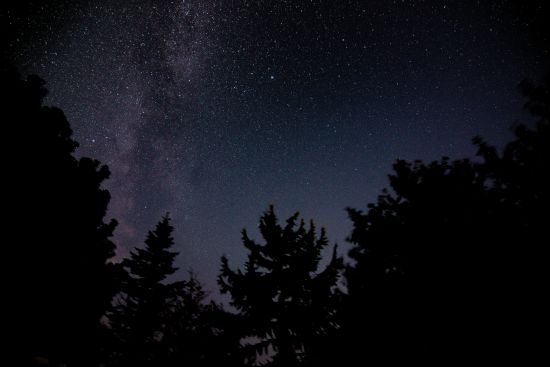 Fig. 1: EOS 200D, Tokina f/2.8, 11mm, ISO1600, 5 x 30 seconds, processed from RAW
Fig. 1: EOS 200D, Tokina f/2.8, 11mm, ISO1600, 5 x 30 seconds, processed from RAW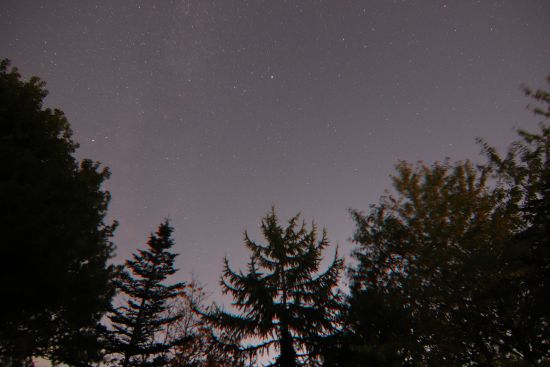 Fig. 1: EOS 200D, Tokina f/2.8, 11mm, ISO1600, 1 x 30 seconds, uncorrected JPEG
Fig. 1: EOS 200D, Tokina f/2.8, 11mm, ISO1600, 1 x 30 seconds, uncorrected JPEG
The second image is comprised of 6x 120 second exposures at ISO 3200. Something that I could have technically done without the shutter release cable, but not something I'd want to stand around counting down and pressing the button for; the app for the tracker did it all brilliantly.
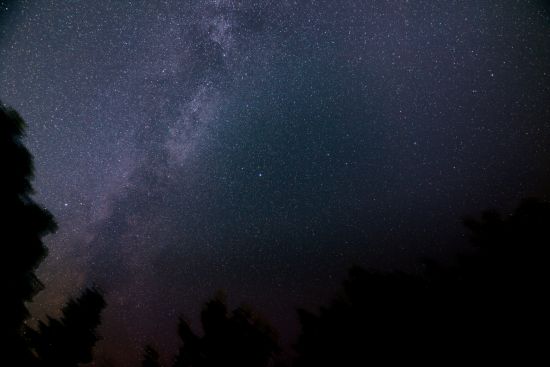 Fig. 1: EOS 200D, Tokina f/2.8, 11mm, ISO3200, 6 x 120 seconds, processed from RAW
Fig. 1: EOS 200D, Tokina f/2.8, 11mm, ISO3200, 6 x 120 seconds, processed from RAW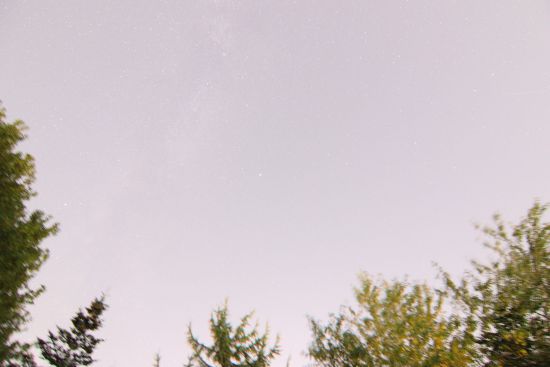 Fig. 1: EOS 200D, Tokina f/2.8, 11mm, ISO3200, 1 x 120 seconds, uncorrected JPEG
Fig. 1: EOS 200D, Tokina f/2.8, 11mm, ISO3200, 1 x 120 seconds, uncorrected JPEG
There was a fairly lurid coloured moon this night, so I also switched out to my only other lens available my 105mm Sigma macro:
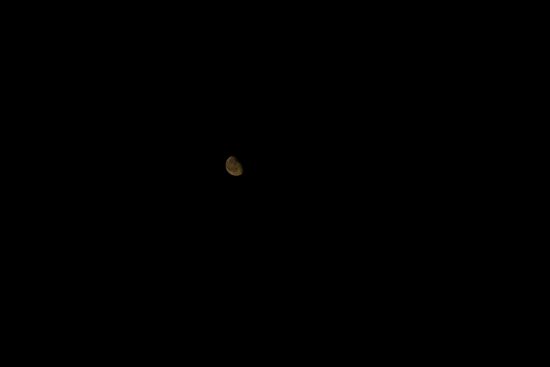 Fig. 1: EOS 200D, Sigma f/2.8, 105mm, ISO200, 1 x 1/60 seconds at f11, processed from RAW
Fig. 1: EOS 200D, Sigma f/2.8, 105mm, ISO200, 1 x 1/60 seconds at f11, processed from RAW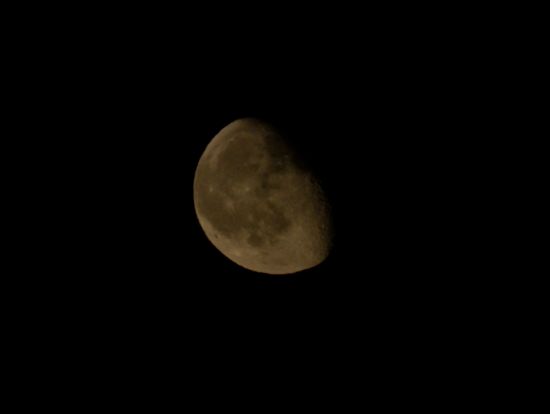 Fig. 1: EOS 200D, Sigma f/2.8, 105mm, ISO200, 1 x 1/60 seconds at f11, centre crop
Fig. 1: EOS 200D, Sigma f/2.8, 105mm, ISO200, 1 x 1/60 seconds at f11, centre crop
Image Processing Notes
Since this was my first time stacking and processing multiple images, it took a while until I found a solution that (a) worked properly on Linux, (b) I was comfortable with and ©, was happy with the output from.
First I tried Siril, but I just couldn't get to grips with the interface - I found it entirely unintuitive and the tutorial to stack your images just would not run - throwing an error about a line in the pre-processing script which made no sense.
Then I tried DeepSkyStacker which, although Windows only, seemed to load and run via Wine, but ended up crashing repeatedly when processing images.
Eventually I looked at ASTAP which did everything I wanted and was clearly laid out.
I tried loading images into the applications as the came from the camera, but all of my results were over-exposed, suffering varying levels of optical aberrations and just generally didn't look particularly great - even though stacking brought out far more detail than I had seen before.
Eventually I settled on the following routine (which works well for me, in my fairly light-polluted garden):
1. Load RAW files into Rawtherapee and adjust as below
The chromatic aberration settings are likely particular to my lens which is of course in this case is the ultra-wide 11mm Tokina. At 11mm and f/2.8 it has quite bad chroma in the corners of the image. It would likely not need such aggressive settings stopped down, or at the other end of it's focal length (16mm).
2. Save as TIFF, 16bit. Load into GIMP and apply gradient as below in the direction of any light pollution
Depending on the level of light pollution, increase/decrease the opacity of the gradient, as well as the length it is applied to.
3. Load all of the processed TIFF files into ASTAP as your light files. There will be some warnings about missing metadata, but this doesn't appear to impact the final image.
4. Let ASTAP do the stacking, along with any dark, flat and bias images.
For me, the best results were with the AstroSimple option and Sigma Clip stacking options as above.
5. In the resulting stacked image, if the star colours look off, try another stacking/colour de-mosaic algorithm, or try the 'Autocorrect image colours' option from the tools menu.
6. Export as TIFF from ASTAP and load back into your image editor of choice. I used Rawtherapee to do final image/colour enhancements; playing with the colour and black/white highlight balance.
